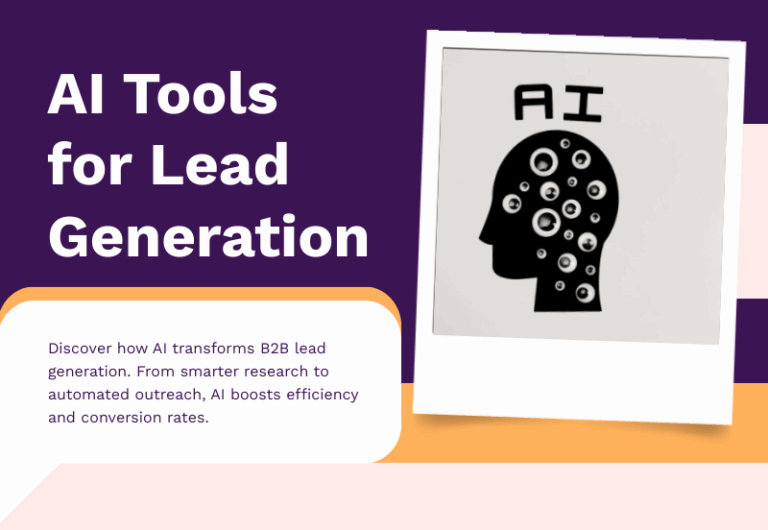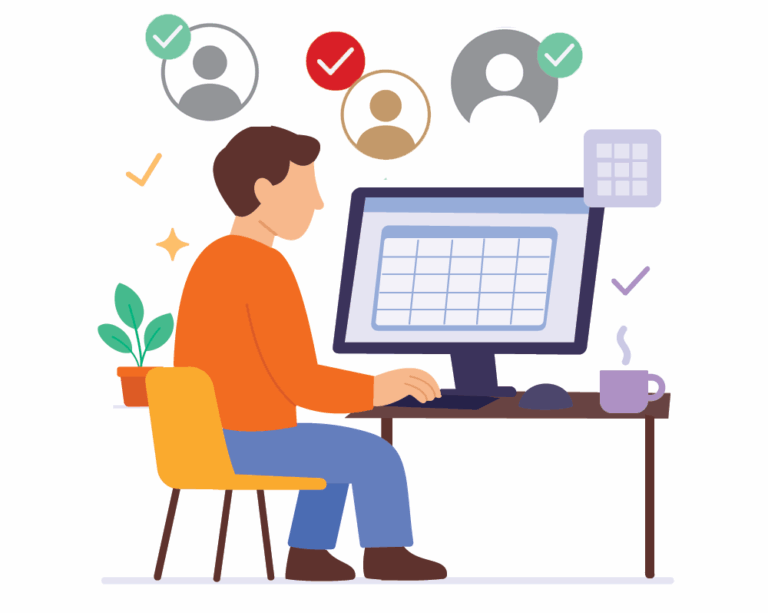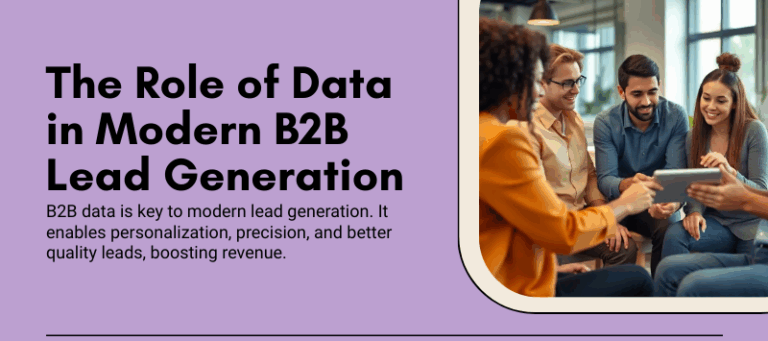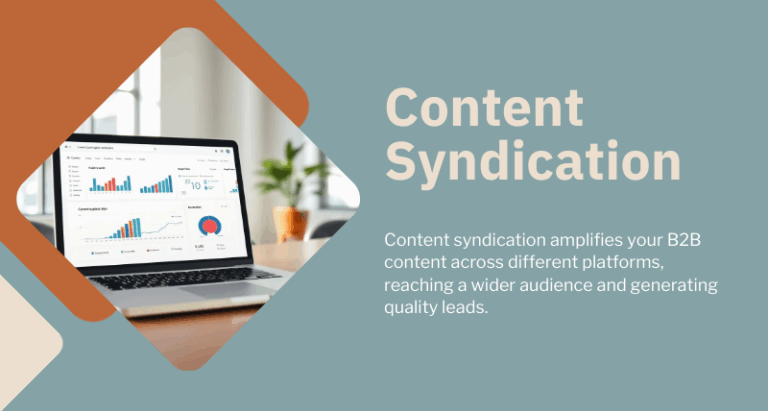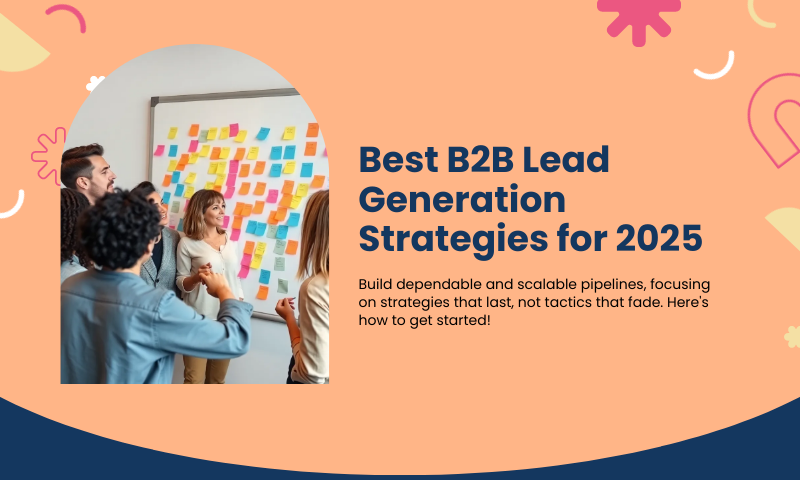
B2B lead generation has broken from the old formula of blasting cold lists and running generic paid campaigns. Traditional levers—mass prospect lists, opaque targeting, spray-and-pray email—are becoming increasingly unreliable. The organizations that will thrive are those that (1) own and orchestrate consented first-party signals, (2) deploy AI to enhance—not replace—expert human judgment, (3) build authority through expert content and presence, (4) re-center their demand creation around events and real interactions, and (5) treat email and outreach as precision, compliance-grade channels.
This article is a roadmap for executives, growth leaders, and operators who want to build dependable, scalable pipelines — not experiment with tactics that fade.
1. Build Around First-Party Data & Intent
Why it’s essential in 2025
With privacy regulation tightening and platform controls shifting, third-party data targeting is no longer a stable foundation. The durable advantage lies in claiming and activating your own consented signals—site behavior, product trial usage, content engagement tied to account identity.
How to do it
- Instrument deeply: Track fine-grained behaviors (downloads, heatmap clicks, tool use) and tie them to known accounts via progressive profiling or SSO.
- Value exchange for consent: Offer genuinely helpful assets—tools, ROI calculators, checklists—in return for identity or permissions.
- Clean-room data sharing: If you co-market with partners, share only modeled insights or aggregated signals, not raw lists.
- Data governance: Enforce strict rules and audits for how first-party data is stored, processed, and used to comply with privacy laws.
- Revenue attribution mindset: Make attribution about how many opportunities closed, not which click had the most weight.
Key metrics to track
- Percentage of site traffic tied to known accounts
- New leads and MQLs from first-party channels
- Time from first known touch to qualified meeting
- Conversion rates from consented channels to pipeline
2. Use AI to Augment Human Strategy, Not Replace It
What’s evolved
By 2025, marketing teams accept AI as foundational—but the difference comes in where they apply it. The smartest teams use AI in places where it composes, scores, or surfaces insights, while final decisions remain human-vetted.
High-leverage AI use cases
- Predictive account scoring: Train models on past wins to rank accounts weekly.
- Next-best content or offer recommendation: Tailor what asset to send next based on behavior patterns.
- Routing and SLA enforcement: Automate lead handoffs based on engagement score thresholds.
- Drafting outbound touches: Let AI propose tailored email content, subject lines, and send times—then have humans refine.
- Alerting and anomaly detection: Flag significant account behavior shifts (e.g. multiple stakeholders hitting pricing pages).
Guardrails & governance
- Maintain logs of AI recommendations and human overrides.
- Run A/B tests side by side before fully automating any decision.
- Mandate human-in-the-loop for high-risk content (security statements, legal, pricing).
- Regularly validate against false positives or skewed predictions.
Metrics to examine
- Lift in reply or meeting rates when AI is applied
- Precision and recall of scoring (how many high scores truly convert)
- Reduction in time to first contact
- Incremental pipeline attributed to AI suggestions
3. Be Where Buyers Self-Educate: Expert Content + Social Presence
The new buyer reality
Modern B2B buyers do far more before ever speaking to a rep. You need to occupy their feed, their research path, and their reference library. You win trust by being discoverable and helpful—not interruptive.
Key content and presence strategies
- Executive POV publishing: Have 2–4 company leaders share periodic insight threads or memos—“how we think about segmentation,” “what keeps me up at night,” “lean strategy failures.”
- Artifact library: Package internal frameworks—scorecards, benchmarking tools, requirement templates—as downloadable public assets.
- Platform mix: Don’t spread thin. Focus on one or two platforms (e.g. LinkedIn, niche forums, podcasting) where your audience congregates.
- Community engagement: Answer questions in Slack groups, LinkedIn DMs, or small peer communities. Thoughtful answers lead to credibility.
- Repurposing with intelligence: A single foundational idea can become a detailed blog, a short video, a tweet thread, and a checklist—each tailored for that format.
Metrics to watch
- Shares, saves, bookmarks, downloads (not just likes)
- Inbound meeting requests traced to content
- Unique accounts engaging over time
- Brand / product name searches growing over time
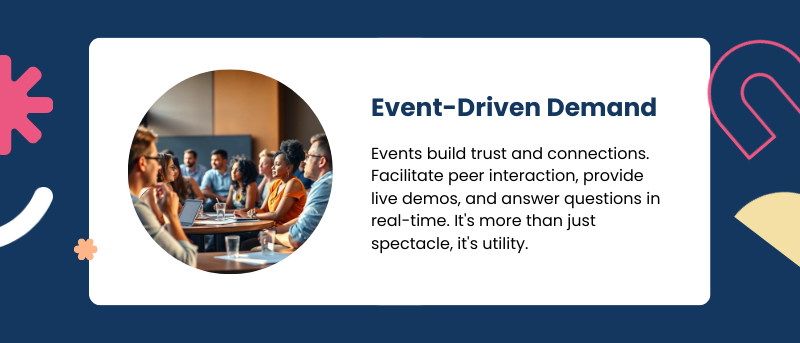
4. Make Event-Driven Demand a Core Lever
Why events still matter
In a world of digital fatigue, well-designed events—whether in person or virtual—accelerate trust, surface intent, and facilitate high-touch connections. For B2B, they help buyers connect with peers, see proof live, and ask questions in context.
Best practices for impact
- Utility over spectacle: Run hands-on workshops, peer panels, breakout labs—less pitch, more experience.
- ABM integration: Invite specific target accounts and use event attendance as a trigger for stronger engagement.
- Deep instrumentation: Track which sessions attendees visited, how they engaged, and what follow-up maps best.
- After event content funnel: Convert key sessions into eBooks, blog posts, video recaps, annotated decks that continue to drive reach.
- Facilitated follow-ups: Use sales-enabled scripts to convert interested attendees into next-step conversations.
Metrics to aim for
- Meeting rate per 100 registrants
- Opportunity creation from follow-ups
- Pipeline velocity from event cohorts
- Engagement depth (sessions visited, dwell time)
5. Treat Email as a Precision Channel — Not a Spray Gun
Why stringency is required
ISP and inbox providers increasingly enforce aggressive delivery policies. One bad complaint rate spike, and your domain reputation suffers. Email still works — but you must operate it with discipline.
Core email best practices
- Authenticate thoroughly (SPF, DKIM, DMARC) and move toward brand indicators (BIMI)
- One-click unsubscribe and honor requests quickly
- List hygiene & sunsetting: Remove or re-engage dormant contacts
- Segmentation & targeting: Only send outreach when behavior or intent justifies it
- Concise, purposeful copy: 100–120 words max, with vulnerability, insight, or value
- Short sequences: Three touches over a week or two; do not overstay in sequence if no engagement
Key metrics to guard
- Inbox placement / deliverability
- Spam complaint rate (keep well below thresholds)
- Reply/meeting conversion
- Engagement per send (opens, clicks)
6. Make ABM the Thread That Runs Through Everything
ABM as an operating system, not a campaign
In 2025, Account-Based Marketing is less about isolated programs and more the connective tissue that ties content, targeting, outreach, events, partnerships, and customer marketing into a coherent system.
Core ABM tactics
- Tiering using fit + intent: Combine firmographic fit with behavioral signals to pick which accounts to activate.
- Buying-job–mapped content: Create content for the stages of buying: problem recognition, solution research, requirements, supplier selection.
- 90-day sprints: Run coordinate campaigns across marketing, SDR, sales, and CS in aligned cycles.
- Partner overlays: For shared accounts, co-execute webinars, joint assets, and aligned messaging.
What to measure
- Conversion across stages by tier
- Number of buying group participants per account
- Meeting and pipeline yield per targeted account
- Partner-influenced opportunities
7. Create a Low-Friction Confidence Pathway for Buyers
Problem you’re solving
Buyers often stall because they can’t validate product fit or risk reduction internally. Your job: help them move confidently through each step.
Assets to build
- Readiness assessments & configuration tools
- Pricing frameworks / decision logic
- Proof assets / customer use cases by role
- Guided trials or sandboxes with clear success criteria
- Security or compliance materials for technical stakeholders
These deliverables reduce friction, help internal champions justify progress, and make engagement more compelling.
8. Align Outbound to Be “Useful or Invisible”
The mindset shift
Outbound isn’t about flooding inboxes — it’s about sending timely, insight-driven, account-specific messages when the buyer’s context suggests readiness. If your message doesn’t serve them, it’s noise.
Execution approach
- Behavior-triggered sequences: Only outreach when account-level behavior (e.g. multiple stakeholders visiting your ROI page) indicates intent.
- Precision copy: Short, context-rich, offer an insight or question. Avoid generic templates.
- Sequence limits: Three touches over a set window, then pause.
- Artifact inclusion: Always include something tangible—a checklist, a model, a brief—not just a pitch.
- Protection thresholds: Pause or cut sequences if complaint/open rates deteriorate.
9. Embrace Product-Led or Trial-Assisted Approaches (Even for Enterprise)
Why this is possible
Enterprises are growing comfortable with trying parts of systems before committing. A smart pilot or sandbox can surface qualified interest earlier and reduce risk for the buyer and your sales team.
Implementation patterns
- Guarded sandboxes: Provide a limited but relevant experience tied to real data templates or workflows.
- Usage-based qualification (UQL): Promote accounts to sales when certain usage thresholds are crossed (number of projects, integrations, users).
- Facilitated previews: For high-value accounts, curate simulated or templated environments that feel like “their world.”
- Enable CS early: Let customer success engage in the evaluation window to help address rollout or adoption concerns.
Metrics to monitor
- UQL-to-opportunity rate
- Cycle time comparisons vs. non-trial deals
- Engagement depth during trial
- Drop-off reasons and feedback loops

10. Treat Partnerships as a High-Quality Lead Channel
Why partnerships matter
When your product complements a platform or solution, partners often deliver leads that convert at higher quality and lower acquisition cost. More importantly, co-selling builds credibility.
Steps to activate partners
- Select a few anchor partners that overlap your ICP
- Co-create a play: combine webinar, joint asset, reference architecture, co-demo
- Enable partner field sales: include a 30-minute enablement kit with discovery questions, objection handling, example decks
- Reciprocity in leads: route to them leads in their domain; be transparent about sourced vs. influenced deals
Metrics to track
- Opportunities sourced via partners
- Win rate of partner-sourced deals
- Influenced ARR
- Co-sponsored event or asset engagement numbers
11. Operate with Discipline — Fewer Channels, Better Execution
Why focus matters
Running many tactics half-baked creates noise, not pipeline. The best teams pick a few motions and execute them with operational excellence.
Governance framework
- Quarterly motion slate: Choose 2 creation and 2 acceleration motions per quarter.
- Quality gate for campaigns: Each tactic must state what buying job it serves, its risk reduction, and proof of concept.
- Forecasting rigor: Pipeline coverage by source and by age; focus on meetings and opportunities, not form fills.
- Feedback loops: Mandated post-mortems, close-lost interviews, win story capture, and updating playbooks within 30 days.
Implementation Timeline & Checklist
Phase 1 (0–30 days)
- Finalize ICP and account tiers for next 12 months
- Audit email setup (SPF, DKIM, DMARC) and fix any authentication gaps
- Instrument key first-party tracking events and map them to CRM
- Publish confidence assets (checklists, calculators, pricing framework)
- Kick off executive POV content program
- Begin a pilot behavioral outbound sequence
Phase 2 (30–90 days)
- Launch an ABM + event sprint toward a vertical segment
- Deploy predictive account scoring and compare to baseline
- Establish a partner play for one anchor collaborator
- Release a sandbox/trial or guided preview path
- Build workflows to progressively route qualified behavior into outreach
Phase 3 and ongoing
- Review pipeline quality monthly; pause underperforming channels
- Refresh content per buying stage every quarter
- Monitor deliverability metrics and domain reputation weekly
- Formalize playbooks and team enablement documentation
- Scale what works; sunset what doesn’t
Common Mistakes to Avoid (and What to Do Instead)
- Mistake: Gating everything.
Do instead: Ungate discovery assets to grow reach; gate only high-value tools with clear exchange. - Mistake: Over-sequencing outbound.
Do instead: Three touches max; pause unless new behavior appears. - Mistake: Reporting on clicks as success.
Do instead: Measure to meeting and stage change; use opens/clicks as diagnostics, not victory laps. - Mistake: Spreading thin across too many channels.
Do instead: Pick two creation motions (e.g., events + POV content) and two acceleration motions (email + outbound), and execute with rigor. - Mistake: “Demo?” as the only CTA.
Do instead: Offer a diagnostic, a readiness check, a 5-slide debrief, or a sandbox walkthrough.
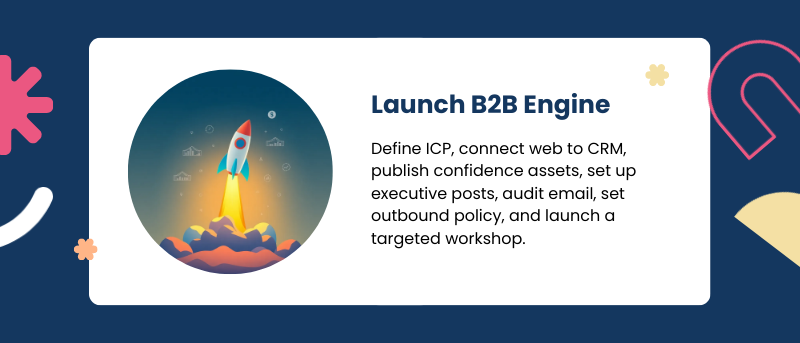
12 Steps to Launch a Modern B2B Lead Engine
- Define ICP and segment tiers (fit + intent).
- Instrument key first-party events; connect web → CRM/CDP.
- Publish three “confidence assets” (checklist, pricing framework, ROI calculator).
- Stand up executive POV posts (1–2/week) and a central resource hub.
- Audit email setup; fix authentication; create sunsetting rules.
- Build a useful or silent outbound policy; cap sequences at 3 touches.
- Launch a targeted workshop with ABM invites (40–60 accounts).
- Set up predictive account scoring; compare to a control cohort.
- Create a guided trial/sandbox path with success criteria.
- Enable a partner play with one anchor platform; co-create a joint brief.
- Establish sprint governance (90 days, shared KPIs, weekly reviews).
- Kill low-yield motions quickly; scale what advances buying jobs.
Quick Compare: Inbound vs. Outbound vs. Events (When to Use Each)
- Inbound (content, SEO, community): Best for compounding authority and attracting problem-aware buyers. Use when you can sustain weekly publishing and have artifacts worth sharing.
- Outbound (triggered outreach): Best for timely nudges when account behavior surges or when you’re entering new verticals with clear hypotheses.
- Events (workshops, roundtables): Best for accelerating trust, facilitating peer validation, and compressing time-to-meeting—especially for Tier-1 ABM accounts.
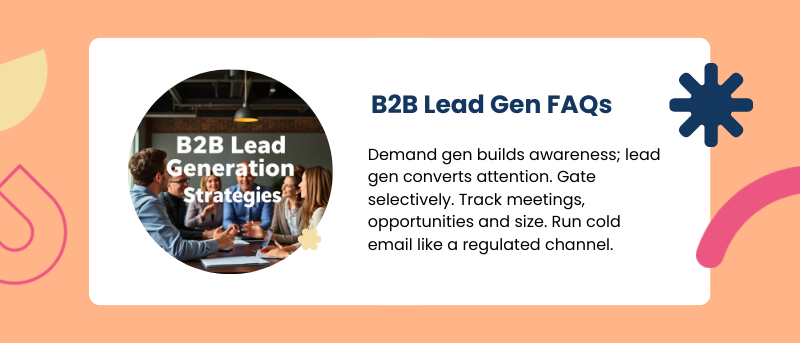
Frequently Asked Questions on B2B Lead Gen Strategies
What’s the difference between demand generation and lead generation?
Short answer: Demand gen builds market awareness and preference; b2b lead gen converts that attention into identifiable opportunities.
Why it matters: Treating them as the same thing leads to premature gating and low-quality leads. In 2025, high performers invest in demand gen (executive POV content, events, community presence) to warm the market, then use precise, consent-based lead capture when buying intent surfaces. A healthy program budgets for both, connects the data layer across them, and measures pipeline yield—not downloads.
Should we gate content or keep it ungated?
Short answer: Gate selectively.
Ungate materials that help discovery (frameworks, checklists, explainers) to maximize reach and sharing. Gate deeper assets (benchmarks, calculators, toolkits) where value exchange is clear and justified. If you gate, keep forms short and offer something tangible—templates, trial access, or readiness scoring—and follow up with context, not a generic demo ask.
What KPIs matter most for B2B lead generation in 2025?
Track meetings booked per targeted account, opportunity creation rate, engaged buying group size (unique stakeholders from the same account), stage progression velocity, inbox health/complaint rate, and partner-sourced pipeline. Vanity metrics (opens, clicks) can be directional, but leadership decisions should rely on movement toward revenue.
Is cold email still effective for B2B?
Yes—if you run it like a regulated channel. That means clean lists, authentication configured, selective triggers for outreach, short 100–120 word messages, and three-touch caps. The goal is “useful or silent”: provide an artifact (diagnostic, checklist, 1-pager), cite the context (why you reached out now), and propose a specific, low-friction next step.
How do we use AI for B2B lead generation without losing authenticity?
Constrain AI to compound human judgment: predictive account scoring, next-best-action suggestions, draft personalization, and anomaly alerts. Keep humans in the loop for voice, claims, and risk. Maintain a policy: what data AI can see, how drafts are reviewed, how outcomes are logged, and how models are tuned. Authenticity comes from human edits and real proof—case logic, numbers, and examples—not from volume.
What is ABM in practical terms?
Account-Based Marketing is an operating system: pick the accounts that matter, surround their buying group with genuinely useful content and experiences, and choreograph marketing + SDR + sales + CS in 90-day sprints. Success looks like more stakeholders engaged per account, clearer problem definition inside the buying group, and faster movement to a qualified conversation.
Should we invest more in LinkedIn or events?
Do both, but sequence them. Use LinkedIn to publish POVs and artifacts that your audience will save and share. Then run events (virtual workshops, small roundtables, hands-on labs) for curated accounts and convert engagement into meetings. Post-event, atomize recordings into short clips, annotated decks, and checklists; redistribute them on LinkedIn to extend reach and catch absentees.
Are product trials viable for enterprise deals?
Yes—when they’re guided. Offer curated sandboxes with realistic data templates, a time-boxed checklist, and success criteria. Introduce customer success early to address rollout and security questions. Define usage-qualified thresholds (UQLs) that trigger sales involvement. Trials reduce perceived risk and create credible internal narratives for your champion.
How many touches should a sequence include in 2025?
Shorter is better: three touches across 7–10 business days, then pause unless new engagement appears. Rotate channels (email + LinkedIn + voicemail) and vary value (artifact → question → offer). Over-sequencing increases complaints, damages domain reputation, and makes it harder for later, well-timed outreach to land.
What’s the best way to align marketing, SDR, and sales?
Run rev-ops cadences around shared segment goals. Each 90-day sprint should define target accounts, buying jobs to support, event plays, outbound triggers, and measurement rules. Hold weekly standups to review engaged accounts, gaps by buying job, upcoming content, and follow-up status. Close-lost/win notes must feed the next sprint’s messaging and targeting.
